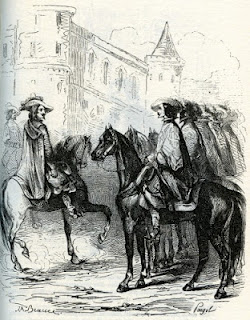 |
| Image believed to be in the public domain |
According to page 16 of En Garde, “Gentlemen will find that a career in the military offers the best opportunities for advancement.” There are seventeen regiments from which to choose (not counting frontier regiments). The ease with which a character is accepted into a given regiment is based upon social level; higher social levels indicate a higher likelihood of acceptance. More desirable regiments require higher social levels. For instance, acceptance into the Royal Foot Guards (the most exclusive regiment) requires a minimum social level of seven; even then there is only a 1-in-3 chance of acceptance (i.e., a roll of at least 5 on a d6). The same social level gives a character a 5-in-6 chance of acceptance to a regiment of lesser renown, such as the 13th Fusiliers. If a character applies to a regiment commanded by another player's character, there is no die roll; the commander's player simply decides. To be accepted, the character must still meet any requirements. For instance, in order join a cavalry regiment, a character must own a horse (which requires a monthly expenditure of crowns for supplies and a groom).
Applying to a regiment requires a week of game time. If the regiment declines to accept the character, he may apply to other regiments in the same week, provided the regiment is of lesser social standing. For every two rejections, a -1 modifier is imposed on future rolls for acceptance.
Once accepted into a regiment, a character may purchase a commission; otherwise, the character will hold the rank of private. This entails spending two weeks of every month performing duties for the regiment. Characters of the next rank, subalterns, “must spend one week of every month on duty...” Characters of higher ranks are not obligated to spend any time on duty. A position in a regiment provides a monthly salary and (in most cases) a monthly amount of status. The amount of salary and status is dependent upon rank and regiment. For instance, a private in the Royal Foot Guards earns 12 crowns and 6 status per month; a private in the 13th Fusiliers earns 4 crowns and no status.
Each regiment has a friendly relationship with another regiment, as well as a regiment with which it has a hostile relationship. Exceptions are the Cardinal's Guard, who have no friends, and the Royal Foot Guards, who have no enemies. Relations among the regiments affect characters for purposes of dueling. A character gains more status when he wins a duel against an opponent from an enemy regiment; however, a character actually loses a status point if he wins a duel against an opponent from a friendly regiment.
Each regiment has a favored weapon (i.e., sabre, rapier, or cutlass). A character can practice with his regiment's favored weapon at no cost. Practice constitutes a week's action and after so many weeks, the character's expertise ability increases by one. A character who chooses to practice with another weapon (or a character who is not in the military) must pay his expertise in crowns for every week of practice. If expertise improvements via practice apply only to one weapon, then it would seem that a character could have as many as three expertise scores – one for each weapon. The rules for practice (p. 15) say that characters can irreversibly convert five points of expertise to one point of strength. Does this apply only to 'comprehensive' expertise or will simple 'cutlass' expertise be sufficient?
According to page 19, “One of the aspects of joining the military is that it is sometimes necessary to go on campaign.” Regular regiments only campaign during the summer season while the frontier regiments campaign every season. While on campaign, a character is exempt from status requirements and need not pay for his usual monthly upkeep. Also, characters can take a leave from their club so as to avoid paying club fees for the duration. A roll on the Force Commitment table indicates which regiments are deployed in a given season. The type of campaign (i.e., siege, assault, defense, or field operations) is determined by a roll on the Force Deployment table. To determine the organization of the campaign army, create a two-digit number using the Force Commitment die result as the first digit and the Force Deployment die result as the second. With this two-digit number, consult the aptly named Force Organization table. The nature of the 'force organization' helps to determine the eventual outcome of the campaign, a topic about which your humble host shall digress in a post next week.
Note: Republished due to Blogger errors.
Note: Republished due to Blogger errors.
No comments:
Post a Comment